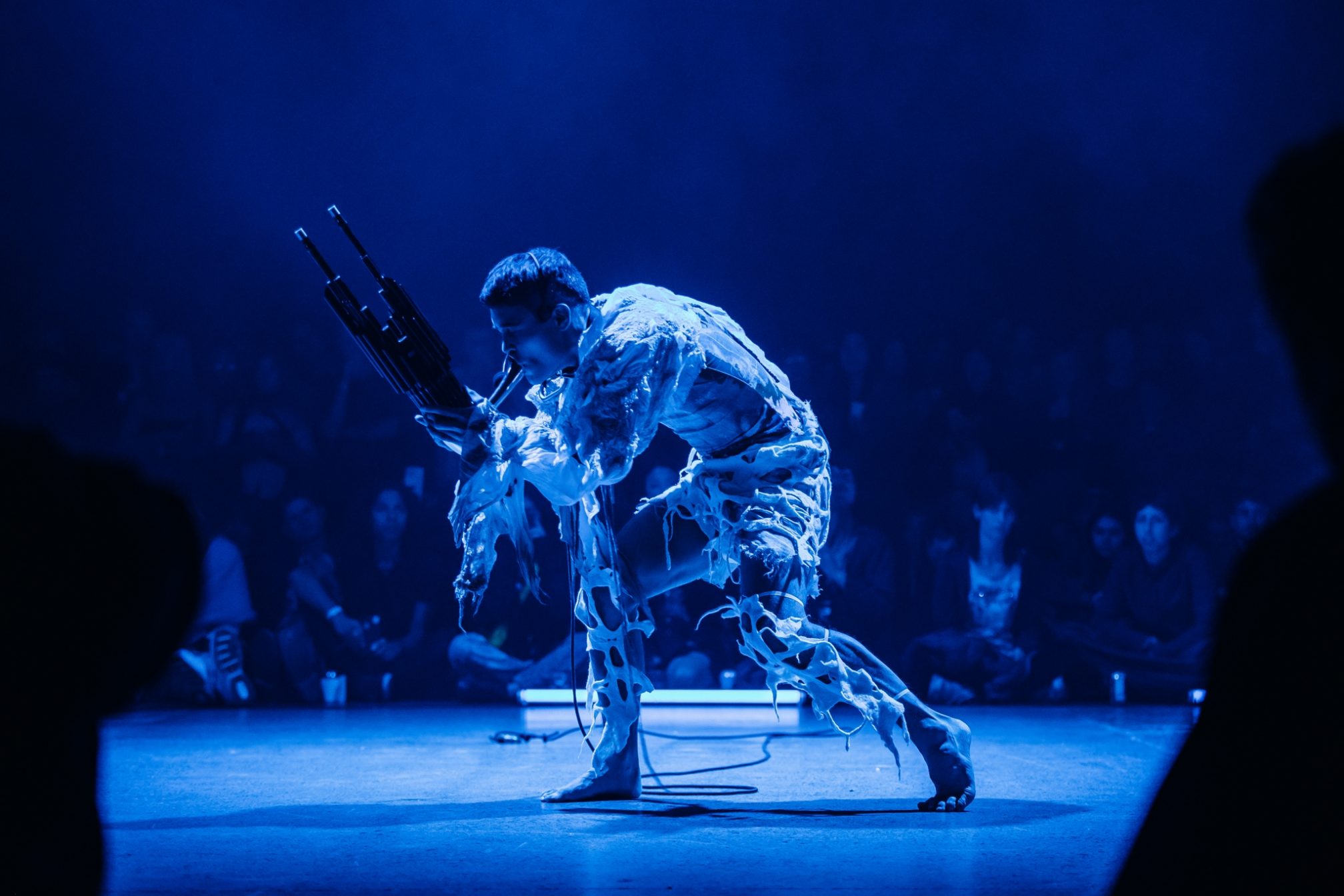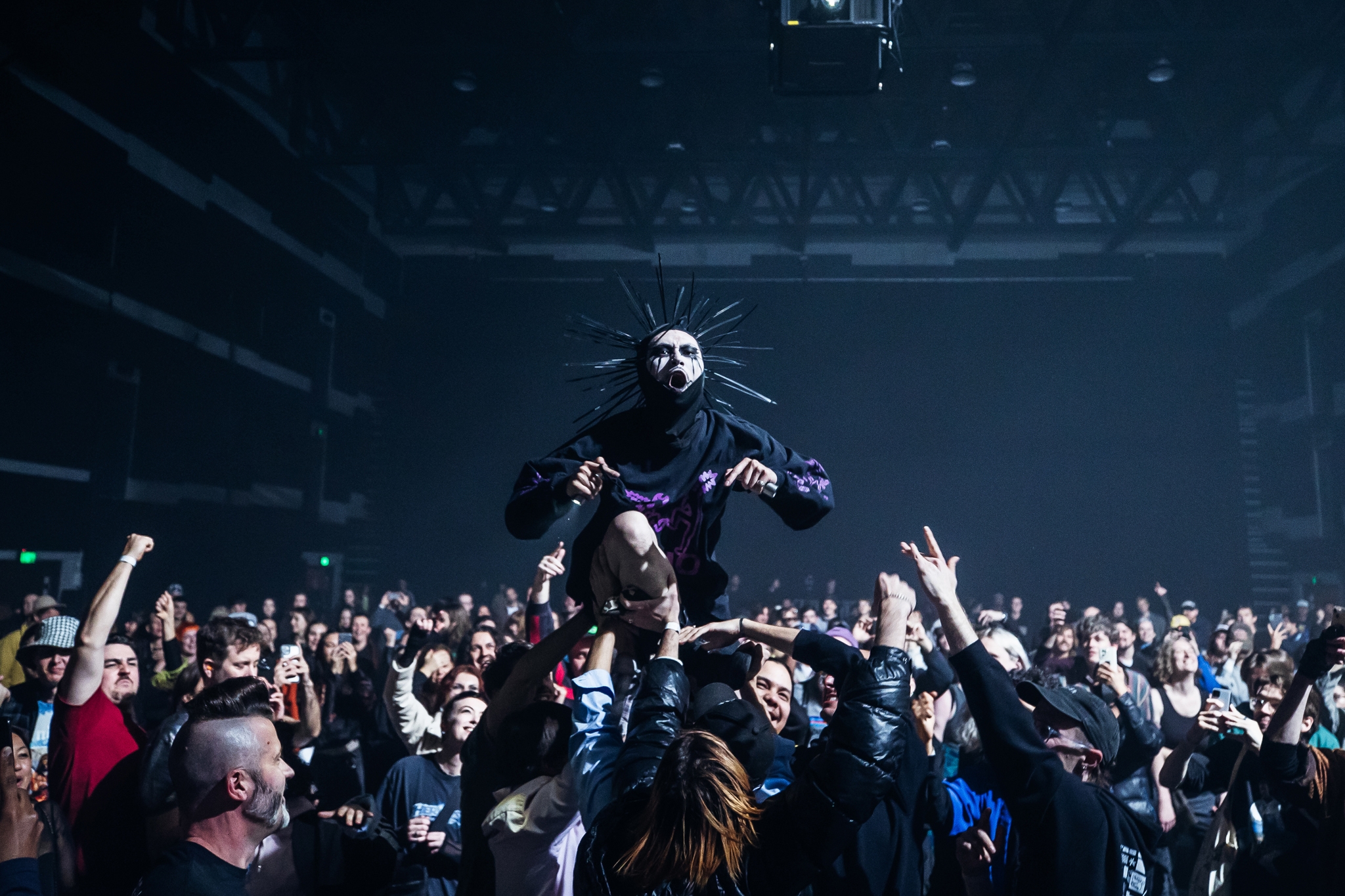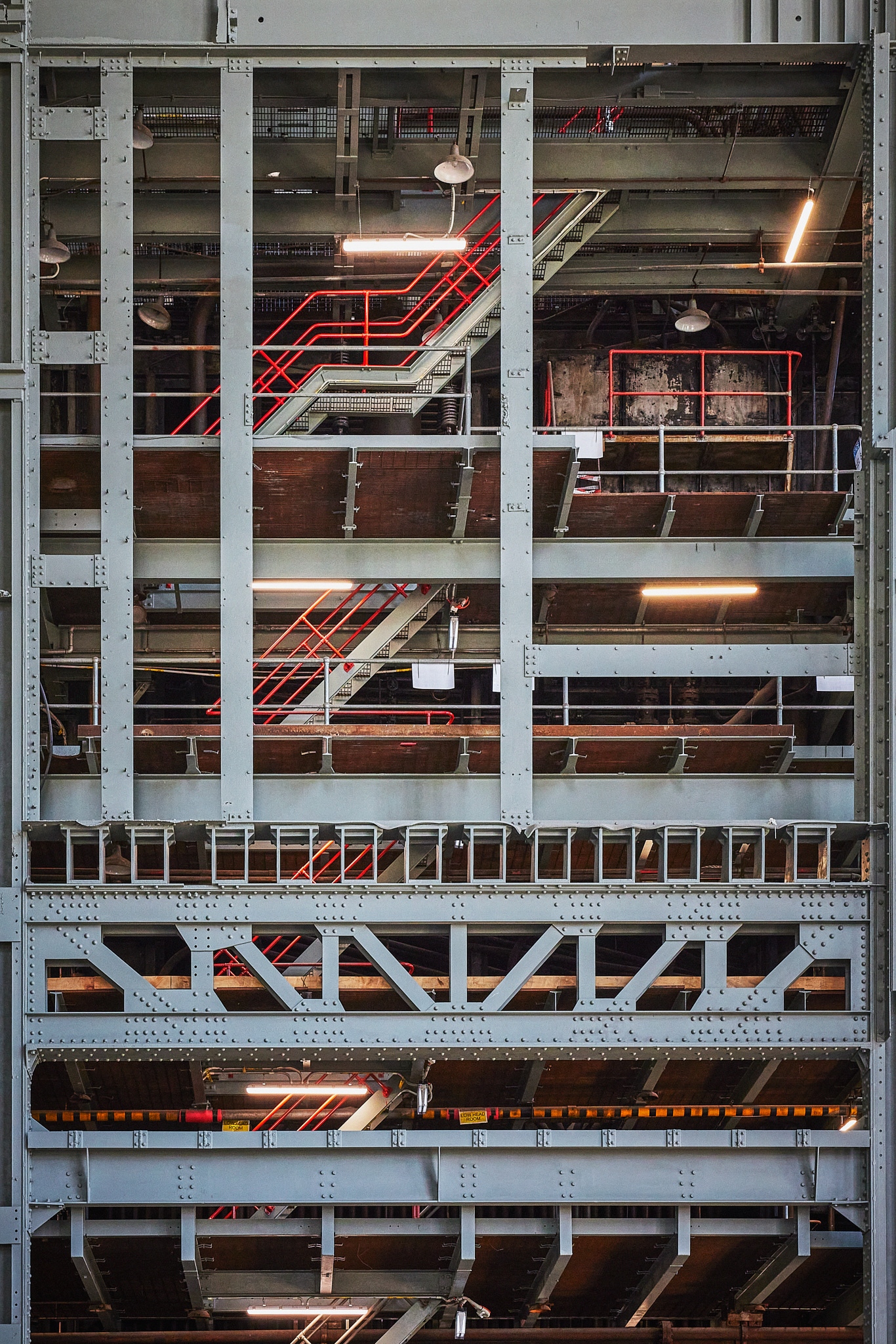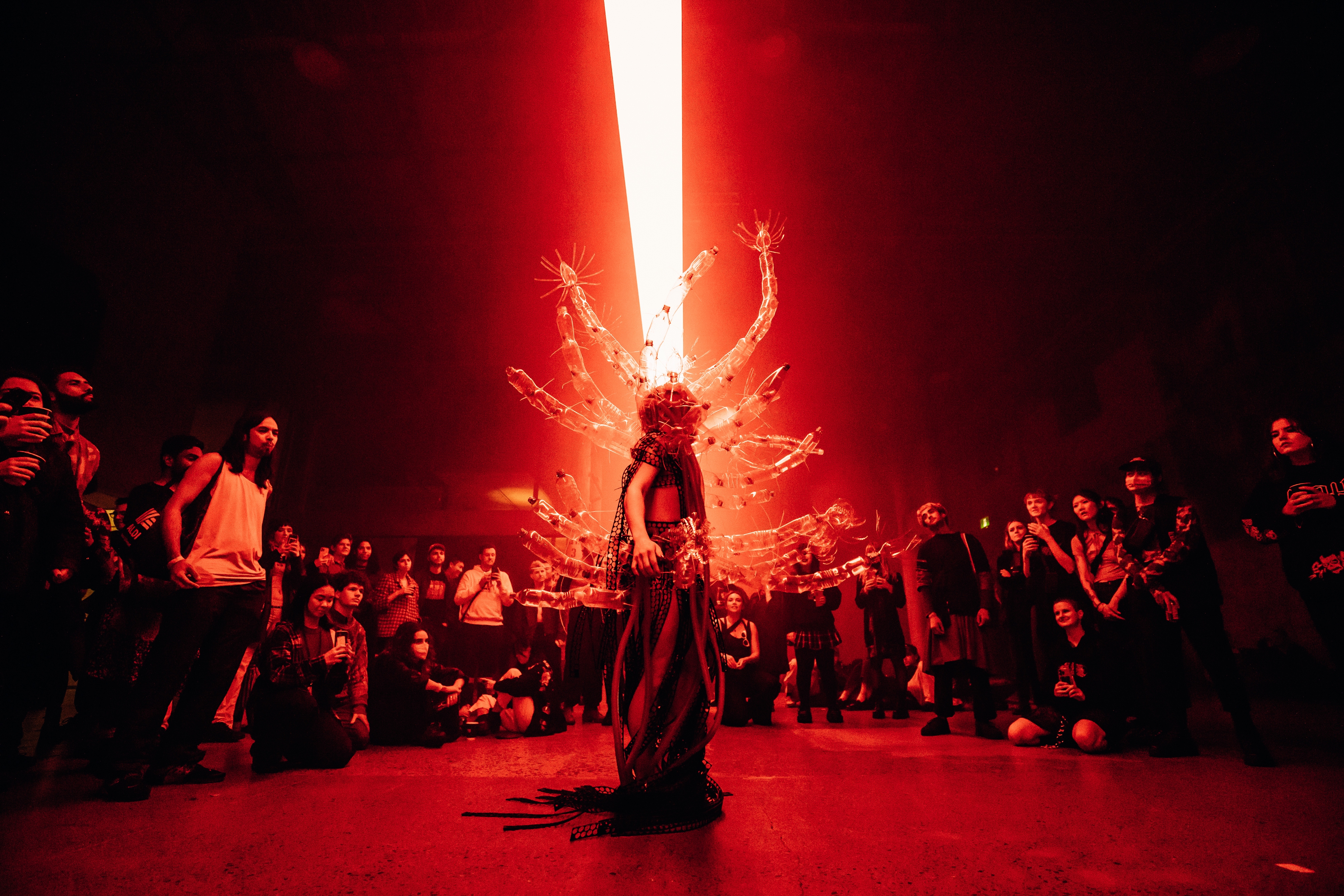 FEATURES
FEATURES
"Don't wade, plunge" into Soft Centre 2025
Co-founder of Gadigal Land/Sydney's most fringe festival, Thorsten Herzog, explains what he hopes for the future of his city.
In a time where the word ‘festival’ is perhaps at its most flexible, Soft Centre is at its most extreme.
Originally starting on Gadigal Land in Sydney in 2017, the festival has taken many forms and existed in various places, but it has always remained true to its inspiration within the more experimental and underground circles of the city it grew up in. Its founders, Sam Whiteside, Jemma Cole, and Thorsten Hertog, have dedicated themselves to the extrasensory fringes and experience of electronic music, sound art, contemporary dance, performance art, light works and new media art.
It's taken them to a lot of places, including their original home of Casula Powerhouse, Carriageworks, the Sydney Opera House, Naarm’s Trades Hall, as well as collaborations with the likes of CTM Festival, MONA, Dark MOFO, Svbkvlt (China), FIBER (Amsterdam), Now Or Never and others.
This year, Soft Centre brings that experience back to its home in Sydney at a time when the focus has never been more squarely on electronic and experimental music. But what Soft Centre has done with electronic music is merely a backdrop, whereas for other events, it remains their highly publicised focus. In 2025, in founder Thorsten Hertog’s words, there’s “more guitars, less DJs,” featuring on its biggest programme to date.
Spanning four days, five venues, and six different events, the festival's return marks its biggest year in some of its home city's most iconic spaces. Its programme is its most ambitious to date, featuring Workshops, Discourse, Cinema, as well as its main festival day and a closing concert at the ‘brand new’ White Bay Power Station.
With the help of the likes of government bodies, and as the first Australian festival to partner with London-based radio station NTS, there’s a lot of trust being placed in the festival, and for good reason. As other ‘big electronic dance events’ can start to feel like a flash in the pan, Soft Centre is further cementing itself as a crucial counterpoint not only to ‘a scene’, but a challenge to its city.
When Soft Centre emerged, Sydney’s ‘underdog’ approach to its nightlife and DIY culture was one that already existed out of necessity. Almost 10 years on, and with far more support at its disposal, what does Soft Centre’s size, scale and ambition say about its hometown?
With the festival starting today, we sat down with one of its founders, Thorsten Hertog, to gain a better understanding of what it is.

Q: Thorsten, thanks so much for making the time to chat with us during what must no doubt be such a hectic period. Firstly, I’d love to know, Soft Centre has consistently delivered multiple stages, huge collaborations and commissioned works, lighting, sound, the works. This year’s event takes that to the next level, though. Compared to the first Soft Centre, what percentage more work would you say this is taking from you, Jemma, Sam and the team?
TH: Well, it’s a fitting moment to reflect on the first year, because there are some real full-circle alignments with this new edition. Mainly, our return to a power station, harking back to those first three years at Casula Powerhouse. In a beautiful twist of fate, the man who literally opened the gates for us back then, Craig Donarski, now happens to be the Manager at White Bay Power Station. Craig had the gall to take a punt on three very naive ravers in 2017, and the rest is history…we owe everything to Craig.
So, what’s changed since then? We’ve expanded into four days, placed a bigger emphasis on knowledge-sharing through discourse and workshops, spread across multiple venues, built a bigger team, and work from an actual office instead of each other's living room (this only started three months ago to be fair). More guitars, less DJs.
What hasn’t changed: our devotion to outsider art, our diehard community, local and emerging talent playing alongside high-profile internationals, and a crew of people working way overtime to make it all happen.
Q: Am I wrong to think that this is the first year that Soft Centre has gone with a multi-venue format? It certainly now has more days than ever before. Why was that an important thing to do this year, of all years?
TH: We actually delivered a multi-venue format with UNFURL in 2022, taking over a cinema in Chinatown, an abandoned office block in Mascot, and a closing concert in the Royal Botanic Gardens headlined by Chuquimamani-Condori. But this is the first time we’ve anchored the expanded model around our flagship multi-stage spectacle, with White Bay Power Station as the centrepiece.
In the long term, we want SOFT CENTRE to function as a destination festival where people travel to Sydney for an extended period, and the city itself becomes the backdrop as much as the events. Each day is designed to unlock a different area of the city while tickling a different part of your brain. Maybe you start with your intellectual fix on Friday at Discourse in Woolloomooloo, before heading to an art deco cinema on Oxford St for an evening of expanded virtual performance. That primes you for the weekend onslaught at White Bay, a choose-your-own-adventure through avant-art in a heritage monolith. From there you jet off to an undisclosed Inner West location for late-night revelry, before returning to White Bay for a highly emo finale, spanning deconstructed trance, devotional harmonium music, and audiovisual synesthesia.
SOFT CENTRE is a momentary detour from the quotidian. And Sydney is the perfect backdrop because it’s a place of cognitive dissonance, at once breathtakingly beautiful, yet oppressive in its costs and corporatisation. It’s harder to build radical third spaces in this context. But I also believe that this tension, the overwhelming frustration that comes from a city not living up to its potential, breeds an intensity - a will or desire to experiment and push back. Our mission has always been to bring outsider art to massive stages, creating a meeting ground for disparate subcultures while redefining how people perceive and relate to Sydney. Hopefully the festival sparks new potentialities for what this city could be.
Q: What do you think stood out to you & the team in selecting these spaces for different moments for Soft Centre 2025?
TH: Our programming is fundamentally site-responsive so the journey always begins with finding the right space. Outside the practicalities of cost, capacity, and available infrastructure, we’re always always drawn to places steeped in history. For example, with PARA.cine, our expanded cinema program exploring emergent tools like VR puppetry, real-time motion capture, and game engine narratives, we specifically wanted a heritage cinema.
Moviegoing has become rarer in the age of TikTok and streaming, but placing these nascent technologies in a nostalgic velvet-seat setting maybe allows us to reframe them – it reminds people that while cinema can be dismantled and reimagined, the essential experience of collective communion is still sacred and can be accessed with these new tools. SOFT CENTRE tries to resist the atomisation that comes with digital tech. Even though our work is perceived as deeply enmeshed in online culture, the festival has always been about devirtualisation — about gathering bodies in space. As Byung-Chul Han writes, festivals return us to a ‘vita contemplativa’, a state of reflection and togetherness that digital culture erodes.

Q: Soft Centre started at a power station. Is the return to a power station just a happy coincidence, or is there some more meaning behind it?
TH: White Bay Power Station is the dream canvas. Beyond its sheer historical weight, its labyrinthine design allows us to fully realise the “choose your own adventure” format that defines SOFT CENTRE. Unlike the shared pilgrimage of single-stage festivals like Inner Varnika or Absorb — which are brilliant in their own right — no two journeys are the same at SOFT CENTRE. You’ll miss things, you’ll stumble into others, and ultimately you’ll leave fried (and hopefully deeply satisfied) by the sensorial overload of it all.
Installations are such a big part of what we do, but sadly that was harder to achieve at Carraigeworks, being embedded in a wider Vivid program. White Bay allowed us to reignite site-reposnsive design and performance making. Giant arachnid light sculptures will be nestled between desolate engines and contorted steam pipes. A 5hr endurance performance exists in a 20 metre long control room, adorned with clocks, levers and pistons that used to direct the production line of this industrial behemoth. SOFT CENTRE is very much concerned with the contemporary and with speculations on what’s next, so an obsolete power station offers a beautiful backdrop for experiments with emergent artforms and tools. There’s also a haunted quality: these sites once sat at the beating heart of industry, but are now obsolete. They remind us of the ephemerality of human systems, their brilliance, their shortfalls, their perils. Art can reanimate those ghosts, making us reflect on how history shapes our present moment and our potential futures.
Equally important is the fact that White Bay sits on Wangal land. We think carefully about how to respectfully honour Country in our programming. This year we ran our first Aboriginal and Torres Strait Islander residency, where artists Keely Eggmolesse and Liam Keenan visited the site to conduct field recordings. Those sounds became the foundation for the pieces they developed during their week-long residency at Brand X, which Liam will present live for tha first time at the Turbine South stage at the Saturday festival. For us, that grounding is crucial: these spaces aren’t just industrial relics, they’re layered with thousands of years of stories, and we want our programming to listen and respond to that history.
Q: What has it been like preparing an event at White Bay Power Station, a space existing in the collective memory of so many Sydneysiders?
TH: Using White Bay as our site is honestly pretty surreal. I sometimes have to pause and appreciate just how special this opportunity is. As a kid driving over the Anzac Bridge, I’d always marvel at the smokestacks, wondering what the hell was inside! It’s such a storied place: since closing in 1982, it’s hosted everything from raves in the ’90s to film shoots for The Matrix and The Great Gatsby, and now it’s been refurbished explicitly for large-scale events. It’s comparable to Kraftwerk, Berghain or Printworks - it’s actually a game-changer for Sydney.
That said, working here doesn’t come without its challenges. Its heritage status brings a lot of red tape and careful site planning. We’re building everything from the ground up..and only have three days of bump-in to do so!
Q: Soft Centre’s programming has long continued to really honour the history of Australia’s own experimental music and art subcultures. This year, Nick Skitz is set to appear, along with many of Australia’s most forward-thinking ‘local’ DJs. Why has that more generational agnostic approach been so important to Soft Centre?
TH: Contemporary music industries are sadly too locked into youth culture, creating a boom-and-bust, “flavour of the month” curatorial mindset. At SOFT CENTRE, we’re interested in drawing dots between generations, especially within Australia, to show that the art we present is part of a longer lineage. Sydney, in particular, has an incredible DIY party history — ohmsnotbombs.net is a great resource to learn more.
This year, I’m particularly excited to host pioneering transhumanist artist Stelarc. His work with prosthetics, techno-bio augmentation, and machine automation still feels startlingly relevant to the present moment.Then there’s Nick Skitz, a true bucket-list booking. He’s undeniably one of Australia’s most prolific DJs, with the Skitzmix series clocking in at dozens of releases. Beyond the WTF curveball factor, his association with the era of CDs and DJ mix compilations evokes a time when people physically sought out music in stores to soundtrack house parties or car rides. Skitz embodies a relic of a bygone music economy, and a better one at that!
This brings me to Liz Pelly, whose work critically examines the contemporary streaming landscape. In her book Mood Machine, Pelly delves into how platforms like Spotify have algorithmic curation over artistic depth. She argues that the promise of “frictionless listening” has led to a homogenisation of music, where tracks are designed to fit into mood-based playlists that maximise ad revenue, which is only becoming more dire with the advent of AI music.
Q: Thorsten, I’d love to know, what does Nick Skitz mean to you personally?
TH: Skitz embodies big room energy, borderline mixes, a party fiend to friendly dad pipeline, the man, the myth, the legend. There would be no Thick without Skitz.

Q: Soft Centre is now at the stage where a lot of its lineup appears to be giving a ‘rare performance’. Ryoji Ikeda is a perfect example of this. What is the team’s process for bringing these people in to each successive event?
TH: SOFT CENTRE is fundamentally a festival of discovery. We aim to stage one-off collaborations, world premieres, and site-specific encounters that create experiences that can’t be replicated or repeated. Over the years, we’ve built a reputation for immaculate artist care, world-class production, and obsessive attention to detail, and I think that gives artists the confidence to take risks and try remarkable things at SOFT CENTRE. It’s not a plug-and-play festival, we’re deeply involved throughout ideation, rehearsal, and pre-production, providing a scaffolding that allows artists to realise their wildest visions.
Q: Soft Centre’s reputation has continued to grow internationally, with a series of incredible collaborations under its belt. A lot of festivals & promoters do this regularly nowadays, but particularly when, say, a big warehouse party promoter from the UK comes to Sydney, it can feel hard to believe that those two events will actually be anything alike. How do you & the SC team bring international experience back home with you?
TH: We’ve been very lucky to travel extensively with our work, and this year’s edition really reflects that. Last year’s residency at New York’s ZeroSpace directly initiated the world premiere of the new Team Rolfes show, which will debut at PARA.cine. Likewise, the showcase of Australian artists at CTM Festival in Berlin this past January has led to a bilateral programming partnership, with CTM co-curating three artists for our Saturday program: Alex Guevara, C Bong Sae, and Null Hypothesis. Attending as punters abroad gives us inspiration that we translate into our programming back home.
The key difference between these kinds of partnerships and a typical “big warehouse party promoter comes to town” scenario is that we work in a co-designed model. International collaborators are brought into our local context, and our expertise shapes their input, rather than trying to copy-paste a foreign template. I’m honestly sceptical of global festival franchises — festivals are inexorably tethered to local ecosystems, knowledge systems, and networks. I couldn’t imagine producing SOFT CENTRE outside of Australia with the same level of detail, care, and ambition that we pride ourselves on.
Q: This reputation has seen London-based broadcaster NTS come on board as a partner this year. How did that relationship come about, & what has it meant for Soft Centre?
TH: The relationship came through Crown Ruler, who manages the Oceania property for NTS. Australia is actually NTS’s second-biggest global listening base, and they’ve been looking to develop more festival partnerships on the back of their success with Rally and Gala in London. SOFT CENTRE is the first Australian festival they’ve ever collaborated with, which is massive for us. There’s a natural synergy between our worlds: a shared commitment to unearthing global subcultures, championing deep-dig selectors, and approaching music with a kind of historical and archaeological lens. With support from Create NSW, we were able to make the partnership really substantial.
Not just branding integration, but four dedicated NTS radio mixes featuring DJs Con Pani, Paramat, 1sayerr, Landfil, Excited State!!!, Rydeen & SOVBLKPSSY; ad campaigns; and NTS residents joining us on the lineup, including Pink Siifu, upsammy, Ran Cap Duo, and Malibu. On a personal level, Malibu is especially meaningful – her show United in Flames has been a go-to for me for years, the soundtrack to many moments of despair, intimacy, and email flow state. Having her as part of SOFT CENTRE feels like a full-circle affirmation of what we’ve been building.
Q: That kind of global brand involvement isn’t without its critics, of course. It’d be remiss of me not to mention that one of NTS’ investors is Universal Music Group, whose CEO has reportedly regularly funded Zionist projects. Where do you think the line gets drawn on what is or isn’t okay when it comes to working with bigger, more commercially-rooted brands?
TH: Anytime you’re dealing with partnerships in the arts, you’re engaging with a complicated web of funding sources, whether that’s government, institutions, or brands. We try not to take a purely black-and-white view of funding, because the reality is that no money is ever completely “clean.” Even government funding, which is the backbone of so much of Australia’s arts ecology and the only reason we can do this thing at scale, comes from complex political and economic structures that can be contested. If we held out for absolute purity, even at this many degrees of separation from the CEO in question, very little cultural work would be possible. Instead, we focus on the intentions behind how resources are used, and whether a partnership enables us to create meaningful opportunities for artists and communities in line with our values.
For us, what matters is whether a partnership aligns with our values and what it tangibly brings to the artists and communities we work with. With NTS, we felt that alignment strongly: they’ve consistently championed underground voices, diverse lineups, and non-commercial musical histories in a way that resonates with SOFT CENTRE’s ethos. That doesn’t mean ignoring the wider politics. We try to stay critically aware, and we believe in transparency, dialogue, and accountability in how we work. But at the end of the day, our priority is building platforms that give experimental artists space and audiences, and that requires navigating complexities without falling into performative posturing.
Q: What are some of the acts or conversations that you yourself are most excited for? Are there any that you don’t think punters can miss?
Liz Pelly - Discourse - the case against music streaming
Hearsay - PARA.cine - cinema as zoological ampitheatre.
Coki - the man who invented dubstep
Karina Utomo x Bhenji Ra - Indonesia and Philipinx ancestral spirits entwined in a ritual exhumation, featuring wind machines and a giant gong.
Litvrgy - transcendental death metal reduced to its purest essence - voice and guitar.
Ecstatic Utopian Fantasy - 10hr endurance spectacle - live camera, writhing bodies, a 20m tall ceiling
Malibu - trance arpeggios over elegiac whispers
Ryoji Ikeda - 1000110101101001011100000
CONTENT.NET.AU: the musical - the first ever Aus Hip Hop musical.
Q: Mixmags around the world appeal to a wide variety of electronic music fans. Do you have any advice for fans who might be curious about Soft Centre but are not sure of how best to approach wading into the perceived depths of its offering?
TH: Don’t wade, plunge.
-
A selection of Soft Centre tickets are still available via their website.
-
Jack Colquhoun is Mixmag ANZ's Managing Editor. Find him on Instagram.


